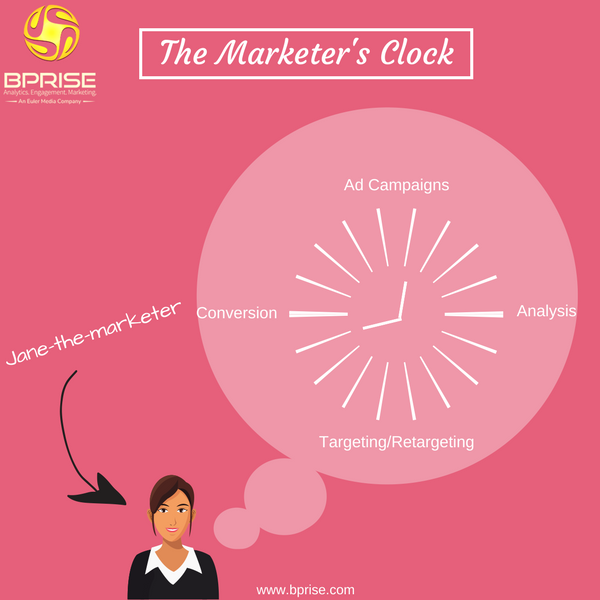Who cares about “ad effectiveness” at 08:30 AM? Ah, my bad. What marketer hits the office at 08:30 AM, anyway? Of course, considering the innumerable tasks that a marketer oversees (sometimes, overlooks), performs (or preempts), the 24-hours-in-a-day-thing does not really work for them.
As someone who works in the Marketing Department primarily, I can tell that no marketer ever has “enough time” on them. All the pre-planned schedule goes for a giant toss and what’s more is that the coin lands on its edge more often than all of us care to admit. You may wonder what’s a marketer onto, that consumes all of their sane time. And if you’re a marketer, then this can be your “constructive read” (sic).
A day in the life of a marketer (let’s call her Jane!) concerns the working on the following…

Scene 1: Digital Marketing
Jane-the-marketer, works her way through multiple creatives, multiple platforms, multiple log-ins, multiple campaign goals, multiple reports, multiple vendors on a regular basis. Although she’s a dedicated marketer, she finds it humanly impossible to smoothly transition between all the aforementioned “multiples“. Now, if her employer (i.e. the advertiser or brand or retailer) is kind enough to split her work by adding new members to marketing, it will mean that the size of the marketing team goes up, in turn increasing the firm’s ad spends. Does having a bulky team deal with multiple platforms and countless vendors ensure that the advertised products meet the respective real-time needs of its target audience?
You and I both know that one-ad-does-not-fit-all. We also know that quantity does not guarantee quality. It is the quality and appropriate fitting of an ad to a situation in the real-life of its target audience that counts. And it most definitely is not the mammoth-sized-ness of the marketing team that counts.
What if we could resolve these issues, for Jane (and marketers like her!) in one shot? How much of an ease would it be on brands (i.e. advertisers/retailers) if they could keep their marketing budgets from skyrocketing and still reach the right customers precisely when they’re in need of a solution/product? How does a relevant, ad-for-a-human sound like?
Scene 2: Analysis
So, marketer Jane, successfully runs ad campaigns across the web and mobile apps and has received reams of data capturing the performance and reach of her ads. She consults a number of third-party vendors to analyze the data and tell her what all the numbers and graphs of data, means simply. A thorough analysis is possible only when marketers have all the information about their target audience’s preferences as consumers. Although Jane divides her time between consulting with various vendors and gathering insights from distinct sources, she’s still deficient of her target audiences’ offline preferences as consumers. What this means is that customers often walk into stores near them and grab what they really need, for a price. There are times, they hop into branded shops or retail stores more than once just to get product-related information. Is Jane even aware of this practice? Let’s say Mary visited A Shoe Shop a couple of times. She spent a considerable amount of time at the heels section but walked out of the shop each time without buying anything. This offline consumer behavior of Mary is invaluable to Jane. Because if Jane was aware of Mary’s offline behavior as a consumer, she could target Mary with an ad of a footwear right when she’d walked out of the Shoe Shop without having made a purchase? Hence relying solely on users’ online data sounds like one is building a lopsided launchpad for the advertising campaigns to take off from.
Wouldn’t it also benefit if you could understand what happens across web, app and stores? What a winner of a deal if the marketer’s ad platform could serve as a one-stop-solution to all of the ad campaign needs? What if the marketer could enjoy the luxury of not having to consult a multitude of vendors for campaign results and customer insights? What if the analysis helped marketers with target lookalike customers? And what if the marketing platform was automated so well that it understood brands’ customers as well a human marketer could?
Scene 3: Targeting & Retargeting
Targeting Prospects
Jane markets products/solutions to prospects as ads over the web, mobile phones and even apps. But given Jane’s limited knowledge of her prospects’ offline consumer behaviour, her ads do not completely resolve their real-life, real-time problems. This results in the ads becoming somewhat irrelevant to her target audience and thus gives way to unimpressive CTRs. Targeting without insights is like driving without the headlights on.
Wouldn’t marketers be able to provide genuinely useful solutions/product recommendations to potential customers in the form of ads had they been aware of the customers’ real-time needs? Imagine all the gains (for the marketer, for the advertiser/retailer and for the customer) when an ad is truly apt for a customer and solves one of their immediate problems?
Retargeting Potentials
Marketer Jane finds that numerous visitors have looked up her brand’s products online but have left without buying anything. Abandoned carts are one of her main concerns as a brand marketer. And she offers discounted product recommendations to her customers in order to win them back. However, customers could have skipped buying the product online given a number of reasons. The product could have been too pricey for them, they could have been browsing just like that, they couldn’t have found what they’re looking for or maybe they wanted to check the same products at a brick and mortar store. Insights that are derived exclusively from an individual’s online activities will never constitute genuine “customer insights“. A customer’s activities are not limited to their online conduct alone and the sooner marketers tap into customers’ offline preferences and consumer needs as well, the better! It is quite the combination of online and offline customer data that constitute true customer insights.
What would make it absolutely easy for marketers to join the dots with customers’ online and offline behaviour and figure out their precise needs? What if all the abandoned carts would suddenly overflow with products of happy patrons?
Scene 4: Conversion
Marketer Jane hits the bull’s eye with her marketing campaign for she sees immediate hike in sales. Let’s say Jane’s ad convinced Mark to buy her brand’s shoes. But does this mean that Jane’s done for the day? Forget the tens of documents she’s got to edit and release! A successful sale or a conversion calls for brands to build on the patron’s interests as a consumer. Brands partially achieve this with the help of loyalty and membership cards; but this practice does not capture all of the user’s online and offline consumer traits. Building a profile with the help of web analytics and proximity-based analytics for every patron will not only help marketers retarget them with relevant content but also help them establish a database of lookalike customers. A lookalike customer is anyone who resembles one or a group of the marketer’s paying patrons. They’re basically prospects that marketers can target on. Also, lookalike customers are external to the database of customers that the advertiser/retailer already has.
Once analytics helps marketers with valuable insights about existing customers, targeting lookalike customers becomes easier. Marketers can target lookalike customers with fitting ads based on the success of their previous ad campaigns.
Insights from Mark’s conversion will help marketers up-sell and cross-sell effectively. Targeting a lookalike customer therefore (say Joe) will not constitute a shot in the dark because Jane has historic data to substantiate the possibility of Joe (who is a lot like Mark as a consumer) converting!
What if marketers could target lookalike customers as soon as their inventory gets restocked? Nothing like the ability to up-sell and cross-sell relevant products to patrons; how do marketers achieve all this?

Having a simple but powerful ad platform that not only optimizes marketers’ reach with ads that are truly relevant to the brand’s customers, right when they’re in need is quite the evolution in marketing. This evolution will not only bring down the firm’s marketing expenses but also allow the brand to have an efficient, slim marketing team. Which is why, marketers, rather advertisers/retailers that are quick to adopt the same could save considerably. Predictive analytics ad platforms like the one BPRISE offers, gathers information and learns user behavior.
If marketer Jane, were to use BPRISE’S programmatic platform, she’d be able to accomplish everything right from marketing, to targeting, to analytics, to sales, to retargeting, to conversion, to up-selling/cross-selling and looking for lookalike customers, all using a single dashboard. This unified ad platform cuts the need for marketers like her to jump between platforms and wait on countless vendors saving the marketers’ time and money immensely! If you’re a brand that’s looking for answers to the above questions, get in touch with BPRISE asap. Oh, also if you’re the marketer who’s concerned about ad effectiveness at 08:30 AM, we’ll definitely be worth your time!



